INDIAN ARMED FORCES CHIEFS ON
OUR RELENTLESS AND FOCUSED PUBLISHING EFFORTS

SP Guide Publications puts forth a well compiled articulation of issues, pursuits and accomplishments of the Indian Army, over the years

I am confident that SP Guide Publications would continue to inform, inspire and influence.

My compliments to SP Guide Publications for informative and credible reportage on contemporary aerospace issues over the past six decades.
India Inc. Rising
Aero India 2013 was certainly important with regard to the “trade” aspect of the exposition as it would serve to provide a powerful impetus to offset business worth billions of dollars. The air show is expected to be the beginning of fresh dialogue for collaboration and joint ventures between the global and the Indian aerospace industry.
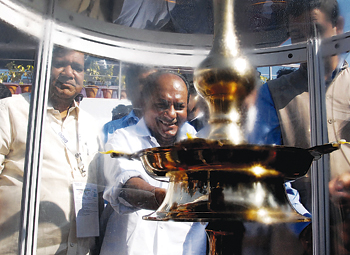
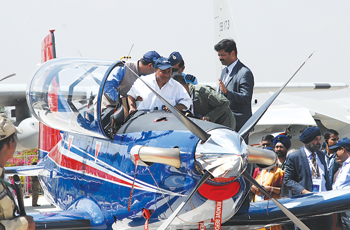
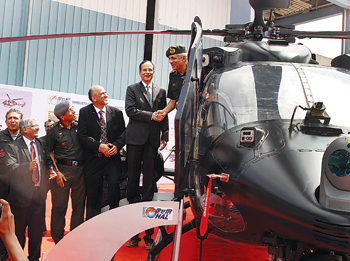
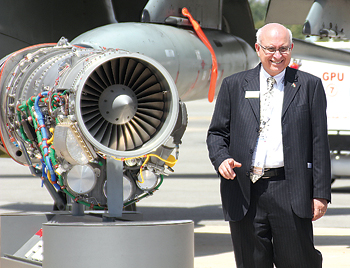
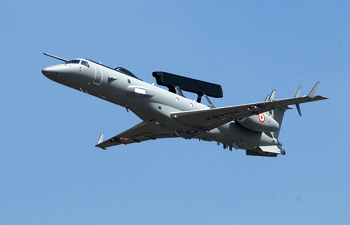
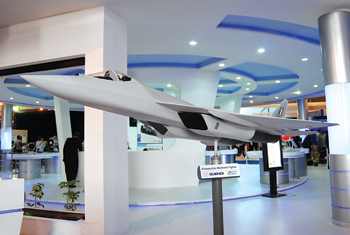
The ninth edition of Aero India, a biennial international air show hosted by the Department of Defence Production under the Indian Ministry of Defence (MoD), was held from February 6 to 10, 2013, at the Indian Air Force (IAF) base at Yelahanka on the northern outskirts of Bengaluru. The air show was organised by the Defence Exhibition Organisation of the MoD in collaboration with the IAF, the Defence Research and Development Organisation (DRDO), Department of Space, and the Ministry of Civil Aviation (MoCA). Overall management of the event was subcontracted by the MoD to the Federation of Indian Chambers of Commerce and Industry (FICCI).
Aero India was preceded by a three-day international seminar at the NIMHANS Convention Centre, Bengaluru, organised by the DRDO in association with the Aeronautical Society of India. Covering a variety of aerospace-related themes, the seminar that has always been held as a prelude to the air show in the past has served to generate new ideas. The seminar also provides an opportunity for participating institutions to establish collaborative programmes for research and technology partnerships.
Aero India: Driven by Market Potential
An international aerospace exposition such as Aero India is aimed at projecting India’s emergence as an attractive market, as well as a key outsourcing hub for the global aerospace industry. Participation in the air show, especially by the global aerospace industry, is driven essentially by the enormous and lucrative market potential for aerial platforms and weapon systems that a rising power like India has to offer. Today, with the projected expenditure of $100 billion ( Rs. 5,50,000 crore) over the next decade towards defence acquisitions, India is undoubtedly leading the world as importer of military hardware. However, this year, the air show was hosted in the backdrop of several big-ticket purchases for the Indian armed forces already finalised, the prospects for fresh deals in the short term being just a few, and the mega deals likely only in the distant future.
Acquisition Programes
From the newly cultivated sources in the West, the deals already finalised included the acquisition of six Lockheed Martin C-130J Super Hercules for $1 billion ( Rs. 5,500 crore) already in service with the IAF; orders already placed for ten Boeing C-17 Globemaster III strategic airlift aircraft for the IAF worth $5.8 billion ( Rs. 31,900 crore); orders placed for eight Boeing P-8I long-range maritime patrol aircraft for the Indian Navy for $2.1 billion ( Rs. 11,550 crore), the first of which has already been delivered in December 2012; contract concluded for 99 General Electric GE F414 aero engines valued at $750 million ( Rs. 4,125 crore) to power the indigenous light combat aircraft (LCA) Tejas Mk II, designed and developed by the Hindustan Aeronautics Limited (HAL); and the acquisition of 75 Pilatus PC-7 MkII basic turboprop trainer aircraft for $523 million ( Rs. 2,875 crore), induction of which has already commenced. There is a strong possibility of follow-on orders for six additional C-130J aircraft, six C-17s, four P-8Is, as well as for a fairly large number of the Pilatus PC-7 MkII aircraft on an emergency basis to reinforce the basic trainer fleet of the IAF. Deals to procure 22 AH-64D Apache Longbow attack helicopters for $1.4 billion ( Rs. 7,700 crore) and 15 CH-47F Chinook heavy-lift helicopters for $1 billion ( Rs. 5,500 crore), both platforms from Boeing Defense Space and Security (BDS), are likely to be concluded.
Further, two other acquisition programmes are currently in different stages of being processed. These include the tender for six flight refuelling aircraft for around $1.5 billion ( Rs. 8,250 crore) in which the A330 multi-role transport tanker aircraft offered by Airbus Military has been identified as the lowest bidder and for which contract negotiations are likely to commence in the near future. The second is the mega deal for 126 medium multi-role combat aircraft (MMRCA) for over $20 billion ( Rs. 1,10,000 crore) or possibly higher, for which contract negotiations are in progress and is expected to be finalised in the next financial year i.e. 2013-14 if there are no fresh impediments. A major project that is proving to be elusive is the $1 billion ( Rs. 5,500 crore) tender for 197 light utility helicopters which was cancelled in 2007 but was refloated in 2008. With two contenders in the race, namely the Eurocopter AS550 C3 Fennec and the Russian Kamov-226T Sergei, the tendering process is yet to be completed. At this point in time, the time frame for the finalisation of this tender appears somewhat uncertain and hence ought not to be regarded as a “done deal”.
From the traditional source, Russia, there are a number of ongoing programmes. These include orders placed for 139 Mi-17V5, the induction of which has already begun, as also the 42 Su-30MKI combat platforms through the Hindustan Aeronautics Limited. Furthermore, HAL has entered into an agreement with United Aircraft Corporation of Russia for the co-development and co-production of twin-engine multi-role transport aircraft (MTA) to replace the ageing An-32 fleet of the IAF. The initial order from the IAF is for 45 platforms and 105 from Russia. HAL has also entered into an agreement with Sukhoi and Rosoboronexport of Russia for the fifth-generation fighter aircraft (FGFA), a two-seat derivative of the single-seat Russian T50 PAK FA. To be produced in India by HAL on completion of its development, the IAF will receive 214 of these fifth-generation machines. On the indigenous front, HAL has a variety of commitments for its largest customer, the IAF. These include 159 advanced light helicopter (ALH) Dhruv; 76 of its weaponised version, the Rudra, which was formally handed over to the Indian Army Aviation Corps at Aero India 2013; 179 of the light combat helicopter (LCH) currently under development; and 187 light utility helicopters (LUH) also under development.
Acquisition Programes Ahead
Despite the fact that contracts for aircraft and aero engines worth over $12.6 billion ( Rs. 70,000 crore) have already been concluded or are about to be inked and that product/vendors have already been selected for deals worth another $21 billion ( Rs. 1,15,500 crore), there is no lack of enthusiasm on the part of the global aerospace and defence industries in the market potential in India. The global aerospace majors are eyeing fresh deals likely to materialise in the short term. These include the Rs. 12,000 crore ($2.2 billion) project for 56 medium-tactical transport aircraft to replace the ageing fleet of the HS 748 Avro twin-engine transport aircraft acquired from Britain in the 1960s. In the rotarywing regime, the Indian Navy has floated a global tender for procuring 56 light-utility helicopters. The tender is estimated to be in the region of $900 million ( Rs. 4,950 crore) to replace the fleet of its vintage Cheetah and Chetak helicopters. But a much larger project under consideration by the Indian Navy is for 120 naval multi-role helicopters (NMRH) to replace its ageing fleet of Sea King helicopters acquired in the 1980s as also to enhance its capabilities in tandem with the growing responsibilities in the region. The contract, if and when concluded, is expected to be in the region of Rs. 35,000 crore ($6.4 billion). The major global military helicopter manufacturing companies such as Eurocopter and AgustaWestland from Europe as also Sikorsky and Lockheed Martin from the US were present at the air show with the latest from their stables.
Business potential of about $9.5 billion (in excess of Rs. 52,000 crore) over the next decade apparently was an incentive strong enough for global aerospace majors to flock to Aero India 2013 in full strength. But apart from the prospects of fresh aircraft deals, what really provided a powerful impetus for Indian companies, especially the small and medium enterprises to showcase their capabilities at the exposition, is the lure of offset business of over $3.3 billion ( Rs. 18,150 crore) generated by the deals already concluded. Of greater significance is the offset obligation pegged at 50 per cent for the MMRCA deal which could be to the tune of $10 billion ( Rs. 55,000 crore) or even higher. Collectively, it is a windfall for the indigenous aerospace industry especially the private sector. In Aero India 2013, the focus has shifted from new generation and sophisticated aerial platforms to the supporting industries, joint ventures and small players.
Enthusiastic Participation
It is little wonder therefore, that in the ninth edition of the show, there were over 700 companies, around 100 more than in the previous edition where business potential was much larger. There were in all 27 countries represented at the air show as participants and there were 78 delegations from overseas. The exhibition area this time was 1,25,000 square metres as against 75,000 square metres in 2011. The major participants were aerospace companies from the United States, Israel, Russia, France, UK, Germany, Belgium, Bulgaria, Italy, Ukraine, Australia, Belarus, Czech Republic, Japan, Norway, South Africa, Spain, Switzerland, Austria, Brazil, Canada, the Netherlands, Romania, Sweden, UAE and Singapore. National pavilions were set up by ten different countries, namely Belgium, Bulgaria, Italy, Israel, Russia, Germany, France, UK, Ukraine and the US. Amongst the international participants, the US companies that outnumbered all others, had together occupied the largest indoor floor area, half of Hall E. The US was followed by Israel and Russia. EADS had the largest outdoor pavilion. On the domestic front, DRDO along with ADA occupied the largest indoor and outdoor area of over 2,500 square metres and were followed by the Hindustan Aeronautics Limited, Bharat Electronics Limited (BEL) and Tatas.
Inauguration
The air show was inaugurated by Defence Minister A.K. Antony, who was also the chief guest on the occasion. Among the others present at the inauguration ceremony were Union Minister of Civil Aviation Ajit Singh, Minister of State for Defence Jitendra Singh, Chief of the Air Staff Air Chief Marshal N.A.K. Browne, Chief Minister of Karnataka Jagadish Shettar, Defence Secretary Shashi Kant Sharma, Defence Production Secretary R.K. Mathur, Director General DRDO, Secretary Department of Defence R&D and Chief Scientific Advisor to the Minister of Defence V.K. Saraswat, and FICCI President Naina Lal Kidwai. The ceremony began with a flypast by three Mi-8 helicopters from Air Force Station Yelahanka trooping the Indian national flag, the IAF ensign and the Aero India flag. The inaugural ceremony was witnessed by the Marshal of the Air Force Arjan Singh, officials both civilian and military, industry delegates, exhibitors, representatives of companies from India and abroad and the media.
In his inaugural address, Antony, while reiterating the government’s commitment to rapid modernisation of the Indian armed forces, emphasised the need “to prioritise requirements of aircraft and weapon systems keeping in mind the possibility of imminent cut in the forthcoming budget. He made it clear however, that “the operational readiness of the armed forces will not be compromised due to monetary constraints”. He called for higher degree of self-reliance and scaling up of the defence industrial base through enhanced investment in research and development. He invited the private sector to participate in the defence industry for which a new defence production policy has been put in place since 2010. “There are opportunities for international aerospace majors for partnerships with Indian industry,” said the Defence Minister. Others who addressed the gathering were R.K. Mathur, Naina Lal Kidwai, and Jagadish Shettar.
On this occasion, the Defence Minister released the Government of Karnataka’s newly crafted Aerospace Policy (2013-23), the first such document at the state level in the country. The policy envisions establishing Karnataka as a vibrant and globally recognised aerospace destination in Asia.
The inaugural function was followed by flying displays by a variety of fixedwing aircraft and helicopters ranging from the vintage Tiger Moth to the LCA Tejas, the Flying Bulls of the Czech Republic, Dassault Rafale and the Zephyr ZM-1, a unique canard design aircraft assembled privately in India. The Russian Air Force’s formation aerobatic team, the Red Knights, consisting of five Sukhoi Su-27 UB fighters, that were eagerly awaited, managed to arrive only three days later.
US Aerospace Industry
The largest ever industry delegation sponsored by the US-India Business Council (USIBC) was present at Aero India 2013 to showcase capabilities of the US aerospace industry relevant to the requirements of the Indian armed forces as also for the internal security needs of the country. The aim of the USIBC was also to enhance industrial partnership and play a major role in the programme for modernisation of the Indian armed forces. Purchase of defence equipment by India has increased from around $200 million ( Rs. 1,100 crore) in 2001 to over $14 billion ( Rs. 77,000 crore) in 2013, bulk of it in the last five years.
The leading US defence companies at Aero India were Bell Helicopter, Boeing, Cessna, GE Aviation, Gulfstream Aerospace Corporation, Honeywell, L-3 Aviation Products, Lockheed Martin, Northrop Grumman, Raytheon, Rockwell Collins, Sikorsky and Textron Systems. American aircraft on display included the C-17 Globemaster III strategic airlift aircraft of the US Air Force, C-130J Super Hercules already in service in the IAF, F-16 from the USAF and the KC-135. In the civil aviation segment, the US had the Cessna Citation Mustang and the Caravan turboprop while Hawker had the Beechcraft King Air 350i on display. Other systems from the US industry and of interest to the military, included light armoured vehicles, tactical communications equipment, integrated weapon systems and thermal imaging technologies. “In addition to offering proven US platforms and systems and an end-to-end commitment to customer satisfaction, we are eager to initiate cooperative programmes with India’s defence industry,” said Vice Admiral (Retd) Kevin J. Cosgriff, Senior Vice President, International Business and Government, Textron Systems. Boeing which has especially in recent times been in the forefront of investments in collaboration and partnership with Indian industry, reiterated its commitment to further strengthen relationships and become the aerospace company of choice for both civil and military aviation segments in India.
Rockwell Collins showcased its latest products and technologies at the air show with special emphasis on avionics and communication products. The company aimed to increase awareness of its range of products for both commercial and military applications. The product portfolio included next-generation avionics and communication for aviation, software defined radio, synthetic vision, government systems, airborne software defined radio, flex net radios, avionics for helicopter and transport aircraft, multi-function display system for helicopters, engine monitoring system for aircraft, optical warning system and synthetic vision for helicopters, etc. T.C. Chan, Vice President and Managing Director, Rockwell Collins (Asia Pacific), outlined the company’s growth strategy globally as well as in India and elaborated on the technological innovations that Rockwell Collins will bring to the Indian defence and aerospace market.
Honeywell Aerospace that specialises in automation and control solutions, transportation systems, performance materials and technologies has its growth driven largely by business in China and India. The company sees prospects in India to be bright as according to Pritam Bhavnani, President of Honeywell Aerospace India, the domestic aviation market has been doubling every five years. The company is currently working on the request for proposal (RFP) for the supply of 270 F125IN aero engines for the upgrade of the Jaguar fleet of the IAF.
Lockheed Martin disclosed that the company is investing $20 million ( Rs. 110 crore) on the joint venture at Hyderabad with Tata Advanced Systems to manufacture components for its C-130J Super Hercules aircraft, both for the domestic and export markets. This is a part of the offset obligation for the six C-130J already inducted into the IAF. Textron that owns Bell Helicopter and Cessna, has a team of 500 engineers employed at its centre in Bengaluru and plans to enhance the strength by another 400. The new Managing Director of Textron India, Inderjit Sial disclosed that the company is working on a number of new products that included helicopters, aircraft and surface vessels.
The European Aerospace Industry
The European aerospace industry had a commanding presence at Aero India 2013, dominated by European Aeronautic Defence and Space Company in a large outdoor pavilion which housed its four divisions, Airbus, Astrium, Cassidian and Eurocopter, displaying a broad selection of cutting-edge technologies, products and services. MBDA and Eurofighter had separate indoor stands to showcase their range of products and systems. As per Yves Guillaume, CEO of EADS, companies that are now a part of EADS have been associated with India for nearly five decades, supplying their products for commercial aviation, defence sector and space.
Although somewhat disappointed with the MMRCA tender not going in its favour and hopes of the Eurofighter making a re-entry into the race fading, EADS participated in the exposition with spirits partially revived with the success in the Airbus A330 MMRTT tender. In this tender, the company has emerged as the lowest bidder. Airbus Military is also optimistic about the chances of the C-295/C-235 twin-engine military transport aircraft competing successfully in the bid to be floated by the IAF for a replacement for its HS748 Avro fleet. Airbus Military believes that its heavy airlifter, the A400M military transport aircraft, is an ideal airlift solution for India’s requirements. A mock up of the ATR 72-600 which is now being inducted in Indian carriers, was also on display. Also competing for the Avro replacement is the Alenia Aermacchi C-27J twin-engine military transport aircraft, a model of which was on display at the show.
Cassidian, a subsidiary of EADS dealing with UAVs, sensors, defence electronics and avionics systems, in pursuit of its globalisation strategy, is working closely with Indian DRDO to build foundations for cooperation not only with the Indian aerospace and military industry, but also to access markets in Asia. Also, Eurocopter, a rotorcraft subsidiary of EADS which in 2010 established Eurocopter India Pvt Ltd as a full-fledged subsidiary, showcased its AS565 MB Panther helicopter which is on offer to the Indian Navy and the Indian Coast Guard. After the frustrating abort of the tender in 2007, the company is hopeful that its AS550 C3 Fennec helicopter would emerge as the preferred machine in the second round of tendering for 197 light utility helicopters for the Indian Army and the IAF. Unfortunately, the controversy over the AgustaWestland AW101 deal may cast ominous shadows on the prospects of early finalisation of this tender. Apart from the AS350 B3e, one of the most popular light utility helicopters in India which was available for flight, Eurocopter had on display by way of scale models of the new EC175, that has excellent performance for offshore operations and the performance-enhanced new EC130T2, which shares the technological baseline with the AS350 B3e and is ideal for passenger transport and tourism. Eurocopter sold two EC135 to two different Indian customers at Aero India 2013.
The other European helicopter major AgustaWestland showcased its range of modern high performance military and commercial helicopters at Aero India 2013 which included the AW101 that has been grabbing the headlines for all the wrong reasons, the AW109 light twin-engine military helicopter, the best-selling AW139 medium-twin engine helicopter and the naval variant of the NH90 helicopter. In 2010, AgustaWestland along with Tata Sons Ltd formed a joint venture company called Indian Rotorcraft Ltd located in Hyderabad for the assembly of AW119 commercial helicopters for the global market. The new facility is currently under construction. As per Geoff Hoon, Managing Director, International Business, AgustaWestland, the company is working on a strategy to be a part of India’s growing aerospace industry and Aero India provides a platform for the achievement of this objective. Being the original equipment manufacturer (OEM), AgustaWestland is bidding for the contract for midlife upgrade programme of the Sea King fleet of the Indian Navy. OSS Air and Air Works India have been appointed as authorised service centres for commercial helicopters of AgustaWestland in India.
The IAF’s latest acquisition, a basic turboprop trainer Pilatus PC-7 Mk II from the Swiss company made its public debut at Aero India 2013. Of the 75 aircraft ordered in May 2011, two were delivered to the IAF just before Aero India.
French Aerospace major Dassault was clearly dominating the skies with the impressive aerial display by Rafale that if all goes well with the contract negotiations currently under way, could soon be a frontline fighter of the IAF. It appears that Dassault would prefer to allocate the major portion of work related to offset obligations to Reliance Industries, an Indian entity with which it has established a joint venture instead of HAL which as per the terms of the tender is designated as the lead integrator of the aircraft.
Dassault with an eye on the growing market for high-end business jet in India had the three-engine Falcon 900LX and the twin-engine Falcon 2000S on static display. Also on display was the three-engine Falcon 7X, the latest from their stables. With 20 Falcon jets flying in India, Dassault is moving forward with its plans for aggressive marketing of its business jets in India.
Embraer at the Air Show
Air display at the air show included the first of the three Embraer 145 based airborne early warning and control (AEW&C) system delivered recently to the IAF. This platform is symbolic of a successful joint development programme between Embraer and laboratories of the Indian DRDO. The latter have developed the operational equipment including the sensors and the fixed antenna mounted on top of the fuselage for the phased array surveillance radar. Present in India since 2005 and with 18 business jets of the company currently in operation in India, Embraer had a larger presence at the air show in the business jet segment, showcasing its Lineage 1000, Legacy 650 and the Phenom 100 on the static display. At the show, Embraer made public its agreement with Mumbai-based company Indamer to provide maintenance support for the midsize Legacy 500 which is scheduled to enter service in 2014.
Israeli Presence at Aero India
Technologically rated as amongst the advanced nations in the world, the national pavilion of Israel at Aero India 2013 organised by SIBAT, Israel’s Defence Cooperation Authority under the Ministry of Defence, showcased a variety of systems from the leading companies from its aerospace and defence industry. These included the airborne early warning radar developed for special mission aircraft, medium-altitude long-endurance (MALE) unmanned aerial vehicle and advanced air defence missile systems. One of the unique systems displayed for the first time in India was the Iron Dome, the indigenously developed missile interception system. Other systems on display included the most advanced precision guided weapons, avionics equipment, state-of-the-art command, control, communications, intelligence, surveillance and reconnaissance equipment, as also highly sophisticated protection systems ranging from active electronic countermeasures, electronic warfare systems, decoys and passive armour system. While inaugurating the pavilion, Alon Ushpiz, Ambassador of Israel in India, said, “Many of the Israeli systems on display here in Bengaluru have proven themselves under highly challenging combat operations.” He went on to say, “This pavilion is a symbol of the level of intimacy and cooperation that we have reached with India. Our two nations share a wide array of security challenges. The cooperation in these fields has been an integral part of the growing multifaceted relationship.”
Russia at Aero India
Russia, erstwhile the largest military supplier to India accounting for 70 per cent of Indian defence purchases, has in the recent past, lost several multibillion-dollar contracts to the US or European companies. However, with the order for large numbers of Mi-17V5 helicopters and Su-30MKI combat platforms, Indian contracts with Russian companies is in excess of $7 billion ( Rs. 38,500 crore). The Russian delegation at Aero India was led by Viktor Komardin, Deputy General Director of Rosoboronexport. The state-owned entity was promoting a variety of military equipment which included scale models of the amphibious aircraft Beriev Be-200 Altair, the Kamov Ka-226T Segei that is in the race for the 197 helicopter contract, the latest air defence equipment, the Yak-130 combat trainer, Il-78MK-90 tanker, the newest Il-76MD-90A military transport aircraft, Mi-35M, Mi-26T2 and Ka-31 helicopters as also aerial weapon systems and training aids. Updates on the multi-role transport aircraft and the fifth-generation fighter aircraft (FGFA) programmes were also presented.
The Tenth Edition of the Air Show
Overall, Aero India 2013 was certainly important with regard to the “trade” aspect of the exposition as it would serve to provide a powerful impetus to offset business worth billions of dollars. The air show is expected to be the beginning of fresh dialogue for collaboration and joint ventures between the global and the Indian aerospace industry. Also, the level of entertainment for the public at large especially with the three aerobatic teams was also reasonably high.
As announced during the inauguration by the Defence Minister, the tenth edition of Aero India will be held at Air Force Station at Yelahanka, from February 18 to 22, 2015.





